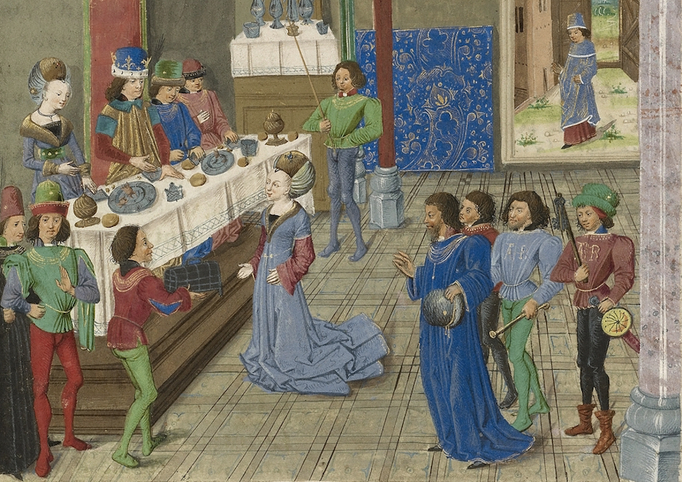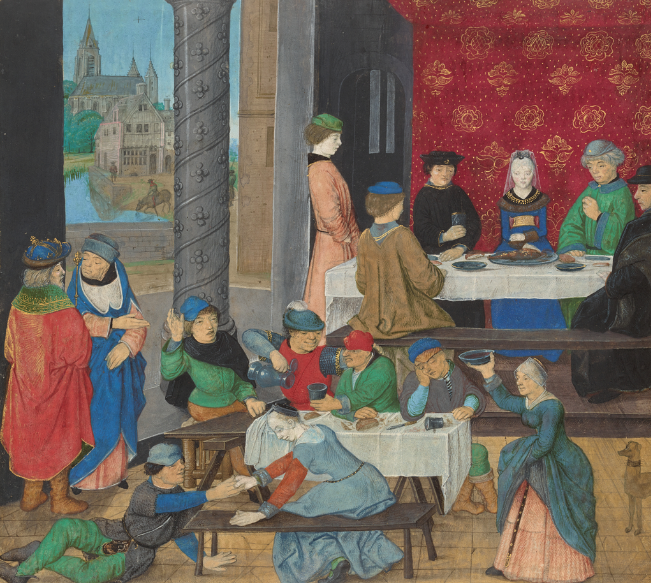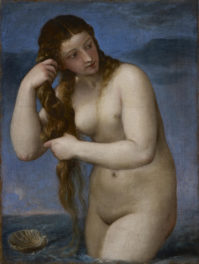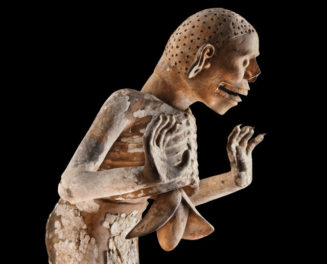
When most people think of a medieval feast, they envision a room filled with boisterous guests and the lusty consumption of hunks of meat and goblets filled with wine. Feasts certainly performed a key social function in aristocratic households, and in the later Middle Ages and Renaissance, some of these feasts were quite splendid and impressive. Artists delighted in illustrating such scenes, often with a remarkably minute level of detail. They depicted each plate, glass, and utensil carefully arranged among dishes filled with bread, fish, meat, and pitchers of wine. In these paintings, wealthy individuals sit in their finest dress at grand tables as multiple servers buzz around to bring them course after course.
Even today, we interpret these vibrant images as celebrations of eating and drinking in a time when food was sometimes scarce for the poor and part of a conspicuous display of wealth and bounty for the upper classes. But amidst all the pageantry and spectacle, it is easy to overlook that something is amiss: Nobody’s eating.
Medieval people had what one might call an uncomfortable relationship with food. Of course sustenance was both essential for survival and a source of pleasure. But when allowed to run wild, pleasure could lead to sin. Overindulging in food and drink trod dangerously close to gluttony, one of the seven deadly sins prohibited by the Church beginning around the 4th century A.D.
I first considered this uneasy balance after my colleague Amy Neff, a professor at the University of Tennessee, pointed it out. A few years ago, she was preparing a fascinating study of images of the biblical story of the Wedding at Cana, in which Christ miraculously transforms jugs of water into fine wine. In image after image, she started to notice a pattern: None of the attendees are ever shown drinking it. Even the steward who samples the vintage and pronounces it superior to wine served earlier in the meal doesn’t actually take a sip.
As I prepared for the exhibition currently on view at the Getty Museum, Eat, Drink, and Be Merry: Food in the Middle Ages and Renaissance, and gathered manuscripts from the Getty’s collection and from a private collection depicting the consumption of food, each and every feasting image supported this observation. Take a look:

Last Supper in a benedictional, Regensburg, about 1030-40, The J. Paul Getty Museum, Ms. Ludwig VII 1, fol. 38
In the earliest manuscript in the exhibition, a 1,000-year-old book of prayers from Regensburg, Germany, has a striking Last Supper scene. At a semicircular table, Christ sits with his apostles and blesses them. Some of his followers pick up knives to eat bread, fish, and, yes, even a pretzel, laid out on the table before them. The two figures closest to Christ raise food to their mouths, but do not actually consume it. Only one apostle ingests the bread—Christ’s betrayer, Judas, who’s seated alone on the side of the table closest to us.
In the biblical text, Christ identifies the rogue apostle by his act of consuming food: “Truly, I say to you, one of you will betray me, one who is eating with me” (Mark 14:18). The sinister black bird that emerges from Judas’s mouth in the image marks not only his sinful act of betrayal, but also his solo consumption of food.

The Temperate and the Intemperate, Master of the Dresden Prayer Book, miniature from Valerius Maximus, The Memorable Deeds and Sayings of the Romans, Bruges, about 1470-80. The J. Paul Getty Museum, Ms. 43, recto
Valerius Maximus, the author of The Memorable Deeds and Sayings of the Romans (circa A.D. 30), appears at far left in blue conversing with the emperor Tiberius. He gestures to two groups of diners, one staid and one rowdy, discussing good and bad behavior of the temperate and the intemperate, respectively. The well-dressed nobility sit in an orderly fashion at the dining table elevated in the back of the room and placed before a luxurious textile cloth of honor. Items on the table are carefully arranged, and each individual sits in his or her proper place. In the foreground, dressed in coarse clothes, the lower-class figures signal the server for more drinks, sleep at the table, and fall off the bench onto the floor. Crumbs and an overturned cup litter the rumpled tablecloth.
Valerius never mentions feasting in his writing, and his text pre-dates the Christian Church and its warnings against gluttony, but the artist responsible for illustrating this 15th-century copy of the text chose to illustrate moral versus immoral behavior through the lens of eating. Although the haphazard arrangement of the “intemperate” people implies overconsumption of food and drink, close examination of the image reveals otherwise. Even those who demonstrate their moral failings with their poor table manners and inappropriate feasting behavior don’t actually eat.

The Feast of Dives, Master of James IV of Scotland, Spinola Hours, Bruges and Ghent, 1510-20, The J. Paul Getty Museum, Ms. Ludwig IX 18, fol. 21v
In this early 16th-century image from the Spinola Hours, the cutaway view displays both the exterior and interior of a well-appointed dining room in a wealthy household. A retinue of servants brings various dishes to the well-fed gentleman’s table, including roast poultry rakishly decorated with one of its own feathers.
More than just a slice of medieval life, this image depicts the biblical story of Lazarus and Dives (the Latin word for “Rich Man”). When Lazarus, a beggar, comes to the door asking for scraps from the table, the Rich Man sets his dogs on him. For medieval Christians, the Rich Man came to represent the epitome of gluttony, not only because he consumed food to excess, but because he failed to share his bounty with others less fortunate. One would expect such a figure to be shown lustily consuming the bounty of his table, but though he raises a bowl, suggesting the impending quaff, it remains a good distance from his mouth. Even a biblical figure closely associated with gluttony does not eat.
Images of feasting that appear in medieval and Renaissance illuminated manuscripts illustrate the types of foods consumed by people at that time, elegant food presentation, and proper table manners. More importantly, they reveal medieval attitudes toward food. In the earlier Middle Ages, and in the context of books used by high-ranking clergy, such as the Regensburg Benedictional, it was desirable to implicate Judas as a sinner through his act of eating and to set up a contrast with the eleven more restrained apostles. Centuries later, as the concept of the seven deadly sins became more entrenched, concern seemed to increase about the depiction of eating, especially in manuscripts owned by wealthy laypeople who might easily be accused of gluttonous behavior at their feasts. The ambiguity revealed in the fact that people do not eat, especially in these later illustrations, expresses the medieval struggle to straddle the fine line between eating enough food to survive and eating to excess.

See all posts in this series »




Fascinating article, and something I’ll never be able to “un-see,” as the saying goes.
But I also wonder if this has something to do with the similar phenomena regarding the depiction of wounds and blemishes in Medieval and Renaissance art: they weren’t depicted because they were considered “transitory” elements (that’s the excuse, anyway). Could not the act of eating be considered similarly?
“one who is eating with me” That could refer to any of the disciples, not just Judas.
What a fascinating article and full of lovely comparative insights about medieval history. Looking at the paintings and manuscripts, I thought, is it necessary for the artist to depict the actual act of eating (consumption) or the processes that make up eating (chewing, swallowing, the pause after one is finished eating and rests for a bit at the table, and the post-meal gestures of drinking water, wiping the mouth / lips with a napkin and clearing the table) — do these painting actually miss out on all these micro-processes? And isn’t holding the food and glass near your mouth and in your hand an implied action that the character is about to eat? Also, who would want their portraits showing something sticking out of their teeth as they eat or a milk or wine droplet on the corner of the mouth? The artists would have surely been instructed to paint the rich characters in a clean, polished and decent manner, right? However, the author does point out that no crumbs are visible on the lips / mouth and the food is depicted whole, not bitten off or half-emptied glasses or food plates. Did the people of those times have any reference book on table manners? Enjoyed reading this piece!
That’s an intriguing idea! There could be some association between the “disgust” factor inherent in wounds and also in excessive eating, but in the later Middle Ages there are quite a few depictions of wounds (often quite graphic), especially those of Christ. In fact, the exhibition, “Eat, Drink, and Be Merry” contains two images where wounds and food are juxtaposed. Lazarus waits for scraps from the rich man’s table, as the dogs lick his sore-covered legs:
http://www.getty.edu/art/collection/objects/3878/master-of-james-iv-of-scotland-the-feast-of-dives-flemish-about-1510-1520/
And a leper receives a bowl of fish from a nun: http://www.getty.edu/art/collection/objects/3224/unknown-maker-initial-d-a-woman-feeding-a-leper-in-bed-swiss-about-1275-1300/
Maybe eating just doesn’t look very appealing. We don’t see a lot of selfies or Thanksgiving family photos showing people putting food in their mouths for that reason–nobody wants their photo taken while their mouth is full. Are there other periods of art where you do see people in the act of eating?
As a photographer I have been asked in the past not to photograph people eating at directors’ dinners as it doesn’t look elegent ….
Muy interesante. Muchas gracias!
I think the explanation is more simple: even today when you take photos during a meal nobody wants to be depicted stuffing their faces. They will always stop taking tbe fork to the mouth and smile. “Cheese!”
Medieval paintings depicting feasts were status symbols, as they showed of the wealth and social statues of those who commissioned them, depicting silver vessels, tapestries, fine clothes, servants, high born friends, etc. I suspect that “eating” was viewed as a necessity that was “common”. You’d no more paint a diners with gobs of meat in their mouths than you would them blowing their noses.
Now here’s a question for YOU: Why is it that no 17th century painting of Dutch interiors show a vase of flowers? Flowers are depicted in still lives, but I’ve yet to come across a painting that shows a vase of flowers on a table. Given Tulip Mania, odd, no? 🙂